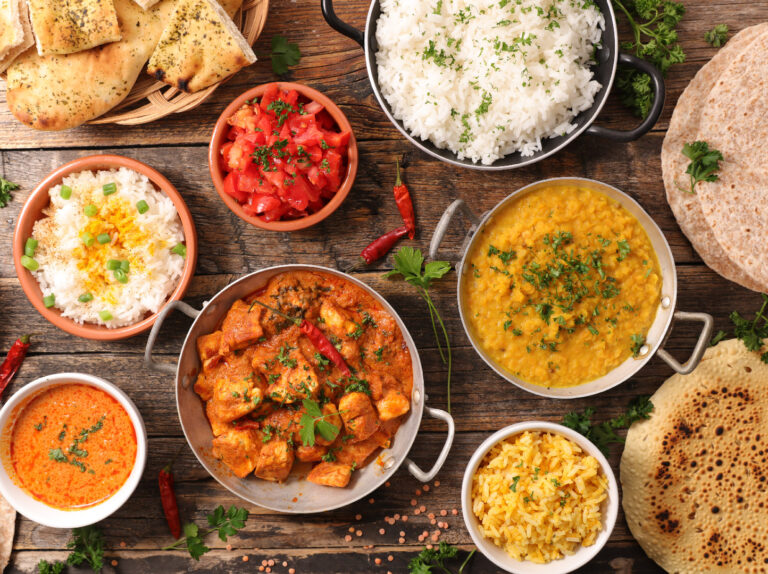Introduction: The Richness of Indian Cuisine
Indian cuisine is well-known for its rich flavors and diverse offerings. It is a reflection of the country’s long and complex history, where different cultures and traditions have left their marks. Indian cuisine is known to be an amalgamation of various regional flavors, spices, and ingredients. It is famous across the world for its unique combination of spices, herbs, vegetables, and meats that create a distinctive taste.
The cuisine is also famous for its vegetarian offerings, which are abundant due to the country’s large vegetarian population. The use of fresh herbs and vegetables is common, making Indian cuisine not just delicious but also healthy. Indian cooking techniques have evolved over time, with many dishes passed down through generations, creating a rich and diverse culinary landscape.
Spices: The Hallmark of Indian Cooking
Spices are the hallmark of Indian cooking. They add flavor, aroma, and color to the dishes. Indian cuisine uses a wide variety of spices, including turmeric, cumin, coriander, cardamom, and many others. These spices are used in different combinations, creating unique flavors. Some dishes are spicy, while others are mild, depending on the type and quantity of spices added.
In addition to enhancing the taste of the food, spices also have medicinal properties, and are used in Ayurvedic medicine. Indian cuisine uses both whole and ground spices, and many dishes require the spices to be roasted or fried before use. The use of spices is a skill that is passed down from generation to generation, making Indian cuisine distinct and flavorful.
Vegetarian Delights: A Key Element of Indian Cuisine
Indian cuisine is known for its vegetarian offerings, which are abundant due to the country’s large vegetarian population. Vegetarian dishes are made from a wide variety of ingredients, including vegetables, lentils, beans, and grains. These dishes are not only healthy but also delicious, and are a key element of Indian cuisine.
Some popular vegetarian dishes include dal makhani, chana masala, and baingan bharta. Paneer, a type of Indian cheese, is also commonly used in vegetarian dishes. The use of fresh herbs and spices is common in vegetarian dishes, making them flavorful and aromatic.
Regional Varieties: A Diverse Culinary Landscape
Indian cuisine is incredibly diverse, with each region offering its unique flavors and dishes. The cuisine varies from state to state, with different regions having their specialties and cooking styles. North Indian cuisine includes dishes such as tandoori chicken, butter chicken, and naan bread, while South Indian cuisine is famous for dosas, idlis, and sambar.
East Indian cuisine includes fish curries and pork dishes, while West Indian cuisine features seafood and vegetarian dishes. Each region has its unique blend of spices and herbs, making Indian cuisine incredibly diverse and flavorful.
Staple Foods: Rice, Bread, and Lentils
Rice, bread, and lentils are staple foods in Indian cuisine. Rice is used in dishes such as biryanis, pulaos, and curries. Bread is also an essential part of Indian cuisine, with varieties such as naan, roti, and parathas. Lentils, or dal, are a source of protein for vegetarians and are used in dishes such as dal makhani, dal fry, and sambar.
These staple foods are used in different combinations, creating a range of flavorful and nutritious dishes. Indian cuisine also includes a range of snacks and street foods, such as samosas, pakoras, and chaat, which often feature these staple foods.
Desserts: A Sweet Ending to Any Indian Meal
Indian cuisine is also famous for its desserts, which are typically sweet and are a perfect way to end a meal. Some popular desserts include rasgullas, gulab jamuns, and jalebis. These desserts are made using ingredients such as milk, sugar, and flour, and are flavored with spices such as cardamom and saffron.
Many Indian desserts are also made using fruits, such as mangoes and bananas, and are flavored with rosewater or syrup. Desserts are an essential part of Indian cuisine and are served on special occasions such as festivals and weddings. Overall, Indian cuisine offers a rich and diverse culinary experience, with something for everyone to enjoy.

